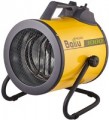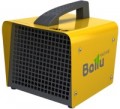Max. heating area
A very conditional parameter that slightly characterizes the purpose by the size of the room. And depending on the height of the ceilings, the layout of the room and the equipment, the actual values may differ significantly. Nevertheless, this item represents the maximum recommended area that the heat gun can effectively heat.
When determining the maximum area, usually, a universal formula is used that is valid for all heaters: 1 m² of floor space in a room with a standard ceiling height of 2.5 m requires 100 W of thermal power. Therefore, if the ceiling height differs markedly from this value, the actual heating area should be recalculated; for more details on scaling, see “Maximum thermal output".
Increase in air temperature (ΔT)
This parameter describes the difference between the air temperature at the inlet to the heater and the outlet temperature — in other words, by how many degrees the air temperature rises when passing through the unit. The higher ΔT, the hotter the outgoing air will be and the more attentively it is necessary to observe safety measures (do not place the device near flammable and heat-sensitive materials, prevent people from being in the immediate vicinity of the gun exit, etc.).
Power consumption
The power consumed by the electrical components of the industrial heater during operation.
This parameter allows, first of all, to assess the load on the power grid and the suitability of the available power for the normal operation of the unit. It is relevant for all types of modern industrial heaters (see "Power supply"). However, it is worth noting that in some electric models, the power consumption is indicated for the ventilation mode. In this mode, the heating element is not activated, and the power consumption is extremely low — a few tens of watts. In such cases, the total power can be estimated from the maximum thermal output (see above) — in electrical models, these parameters practically do not differ from each other.
Heating element
—
Open coil. The simplest type of heater for electric industrial heaters (see "Power supply"): a high-resistance metal coil that heats up when an electric current passes through it. open coil heaters are inexpensive, heat up quickly, provide a large increase in air temperature (see above) and generally have good efficiency. At the same time, dust or other contaminants can get on an open heater, which leads to unpleasant odours, intense heating dries the air, and the heating element is characterized by an increased fire hazard and has a relatively short service life (in other words, it burns out quite quickly from contact) with air, moisture and pollution).
—
Tubular heater. The main element of such devices is also an electric heater (see above), but in this case, it is not installed openly but is enclosed in a metal tube filled with a heat-conducting insulating material (for example, quartz sand). Heating elements heat up somewhat more slowly than open coils, and their heating temperature is lower. However, this type of heater is considered more advanced — primarily because the protected heater is safer and more durable. In addition, a low operating temperature also has its advantages — a large temperature difference at the inlet and outlet is not always convenient, and there are fewer unpleasant odours when the heating element is contaminated.
—
Ceramic.
...The most advanced type of heaters for electric type industrial heaters. Usually, such elements have the form of a series of plates made of special ceramics with high thermal conductivity. Due to this, it is possible to ensure high heat transfer efficiency at low operating temperatures, due to which ceramic heaters do not burn dust and dirt, practically do not create unpleasant odours, and the effect of drying the air from them is not so noticeable. On the other hand, such equipment is expensive.
— Heat exchanger. A type of heater that is used only in water models (see "Power supply") and diesel units of indirect heating (see "Type of diesel heater"). In the first case, the heat exchanger is a circuit through which heated water or other coolant passes, in the second — a combustion chamber of a special design. Anyway, the air passing through the heater is heated by contact with the outer walls of the heat exchanger. To increase the contact area and increase the heating efficiency, these walls often have a complex shape — with ribbed protrusions, plates, etc.
— IR plate. Specially designed plate that transfers heat primarily by infrared radiation. For several technical reasons, it is used only in diesel industrial heaters, and, unlike traditional units, these models do not have a fan. It is because IR radiation does not heat the air, but directly the objects that are under it, so there is no need to provide air circulation. IR heaters are convenient in cases where you need to heat only a relatively small area in a large room; in addition, they can be effectively used even outdoors, where the heat from traditional industrial heaters would simply be dissipated into the atmosphere.Airflow
The maximum amount of air that an industrial heater can pass through itself in a certain time.
This parameter is associated with an increase in air temperature (see above): at constant power, higher performance usually corresponds to a smaller temperature difference. Accordingly, a more efficient industrial heater will heat the entire volume of the room faster, but the heating temperature will be lower. So, it is worth choosing according to this parameter, taking into account what is more important for you — a large temperature difference or a high heating rate.
Power adjustment
The method of adjusting the heating power provided in the design of the heat gun.
- Stepped. Step adjustment assumes the presence of several fixed power values, between which switching is carried out during the tuning process. The accuracy of such a setting is worse than that of a stepless one (see below), even in cases where there are quite a lot of fixed values. At the same time, perfect accuracy is far from always required, and setting a specific value is easier than selecting the position of the regulator with stepless adjustment.
-
Stepless. Stepless systems include adjustment systems that do not have fixed steps and allow you to set the power value in any range from minimum to maximum. Due to this, this setting is extremely accurate, although in some cases it is not as convenient as the stepped one described above.
Max. operating time
The longest time during which the industrial heater can work without interruption.
The value of this parameter depends on the power supply (see above). So, in diesel models, the operating time is usually indicated on one full tank, without refuelling. Note that this implies operation at the lowest power, with minimal fuel consumption, and in optimal environmental conditions. Therefore, when choosing a diesel heat gun for this parameter, it is worth taking a certain margin, or better, separately calculating the operating time at the highest fuel consumption: for this, the volume of the tank (see above) must be divided by the maximum consumption. If we are talking about a gas or electric model, then the maximum operating time usually means the time during which the unit can work without overheating.
Regardless of the type, the long maximum run time provides additional convenience when working with an industrial heater. At the same time, it does not always make sense to pursue the maximum value of this parameter: in fact, the need for continuous heating for a long time occurs quite rarely. In addition, many diesel models allow refuelling right during operation (and in others, the refueling break usually does not exceed a few minutes). Therefore, it is worth specifically looking for a heat gun with a long time of continuous operation only if such a feature is fundamentally important to you.
Tilt adjustment
The ability
to change the tilt angle of the industrial heater. Thanks to this, you can adjust the direction of the air flow not only horizontally (by turning the unit), but also vertically — for example, direct heat to the wall section that needs to be dried first.
Protection class (IP)
An indicator that determines the degree of protection of dangerous (moving and current-carrying) parts of an industrial heater from adverse effects, namely solid objects and water. The level of protection is usually indicated by a marking of the letters IP ("ingress protection")) and two numbers, the first of which indicates protection against the effects of solid objects, and the second — against the ingress of water.
For the first digit, each value corresponds to the following protection values:
1 — protection against objects with a diameter of more than 50 mm (large body surfaces)
2 — from objects with a diameter of more than 12.5 mm (fingers, etc.)
3 — from objects larger than 2.5 mm (most instruments)
4 — from objects more than 1 mm (almost all tools, most wires)
5 — dustproof (full protection against contact; dust can penetrate inside, but does not affect the operation of the device)
6 — dust tight (case with full protection against dust and contact).
For the second digit:
0 — completely unsuitable for contact with water, the device requires protection from moisture and is not suitable for rooms with high humidity.
1 — protection against vertically falling drops of water
2 — from water drops with a deviation of up to 15 ° from the vertical axis of the device
3 — from water drops with a deviation of up to 60 ° from the vertical axis of the device (rain)
4 — against splashes from any...direction 5 — against jets from any direction
6 — from sea waves or strong water jets
7 — the possibility of short-term immersion to a depth of 1 m (without the possibility of continuous operation in immersed mode)
8 — the possibility of long-term immersion to a depth of more than 1 m (with the possibility of continuous operation in immersed mode).
The protection class of industrial heaters, usually, is quite low, because the very principle of operation of these devices involves an abundance of holes and openings.

